Guide to
Meditation Techniques
Meditation Technique #1: Zen Meditation Technique
– Zazen
Goal: Awareness, Detachment, Peace
Zazen (坐禅; Chinese:
zuò chán pinyin
or tso-chan Wade-Giles)
is at the heart of Zen
Buddhist
practice. The aim of zazen is just sitting, "opening the hand of
thought".[1][clarify]
This is done either through koans,
Rinzai's
primary method, or whole-hearted sitting (shikantaza),
the Soto
sect's method. (Rinzai and Soto are the main extant Zen schools in Japan; they
both originated in China as the Linji
and Caodong
schools, respectively.) Once the mind is able to be unhindered by its many
layers, one will then be able to realize one's true Buddha nature[citation
needed]. In Zen Buddhism, zazen (literally "seated meditation")
is a meditative discipline practitioners perform to calm
the body and the mind and experience insight
into the
nature of existence and thereby gain enlightenment (satori).
The posture of zazen is seated, with folded legs and hands, and an erect but
settled spine. The legs are folded in one of the standard sitting styles (see
below). The hands are folded together into a simple mudra
over the belly. In many practices, one breathes from the hara
(the center
of gravity in the belly) and the eyelids are half-lowered, the eyes being
neither fully open nor shut so that the practitioner is not distracted by
outside objects but at the same time is kept awake.
History and tradition
Long periods of zazen, usually performed in groups at a zendo
(meditation hall), may alternate with periods of kinhin
(walking meditation). The beginning of a zazen period is traditionally announced
by ringing a bell three times (shijosho), and the end of a round by
ringing the bell once (hozensho). Before and after sitting, Zen
practitioners perform a gassho bow to their seat, to fellow practitioners
and to the teacher.
In Japan, seated zazen is traditionally performed on a mat called a zabuton
while sitting on a cushion called a zafu.
The common positions used to sit on the zafu are:
- Kekkafuza (full-lotus)
- Hankafuza (half-lotus)
- Burmese (a cross-legged posture in which the ankles are placed
together in front of the sitter)
- Seiza
(a kneeling posture using a bench or zafu)
In addition, it is not uncommon for modern practitioners to sit zazen in a
chair, often with a wedge behind the lower back to help maintain the natural
curve of the spine.
Methods
Very generally speaking, zazen practice is taught in one of three ways.
- Concentration
- Koan
Introspection
- Shikantaza
(just sitting)
Shikantaza is usually associated with the Soto
school, and koan practice with the Rinzai
school. In reality many Zen communities use both methods depending on the
teacher and students.
Concentration
The initial stages of training in zazen will usually emphasize concentration.
By focusing on the breath at the hara,
often aided by counting, one builds up the power of concentration, or joriki.
At some Zen centers, the practice of mentally repeating a mantra
with the breath is used in place of counting breaths for beginners. In some
communities, or sanghas,
the practice is continued in this way until there is some initial experience of samadhi
or "one-pointedness" of mind. At this point the practitioner moves to
one of the other two methods of zazen.
Koan Introspection
Having developed the power of concentration, the practitioner can now focus
his or her attention on a koan as an object of meditation. Since koans are not
solvable by the intellectual reasoning, koan introspection is designed to
shortcut the intellectual process leading to direct realization.
Shikantaza (just sitting)
Shikantaza is objectless meditation, in which the practitioner does not use
any specific object of meditation, but uses the power developed in concentration
to remain completely aware of all phenomena that arise and pass in the present
moment.
Comparison with other practices in Buddhism
Concentration practice in Zen is likened to the practice of samatha
(concentration) in other schools of Buddhism. One apparent difference is that
the eyes remain open in zazen, whereas in the Theravada tradition they do not.
Tibetan Buddhist practitioners keep their eyes open during samatha practice.
Concentration is foundational to most other forms of meditation in Buddhism.
In actuality, all meditative practices, Buddhist and non-Buddhist, take
concentration to execute, and therefore are concentration practices in and of
themselves. Some teachers do not teach concentration as a separate practice,
believing that it is developed through other practices.
Koan introspection and shikantaza are more likened to the vipashyana
(insight) practice in Theravada,
but are sometimes considered to be a condensation of vipashyana and samatha into
a single practice. For this reason, shikantaza can also be referred to as
samatha-vipashyana. Similarly, koan introspection, while leading to insight,
requires an immense amount of concentration on the object of meditation (the
koan).
Zen Meditation Technique is the undisputed heavyweight
in the world of meditation. It is very likely the most widely practiced
meditation technique and is perhaps even the face of meditation. The
silent Buddha, sitting cross-legged, eyes slightly open, in this world but yet
beyond, immersed in a Singularity (or Void) is Zazen.
Zazen is essentially silent, seated meditation and
excellent for a wide range of benefits. If you don’t know which
meditation technique to try, this should be your default choice. Zazen
will help you develop your ability to remain in the moment, mindful of that
which is taking place, and free you from the entanglements of ego-centric,
dualistic thoughts. It will most certainly help you develop a calm
disposition and give you the strength to withstand stressful or upsetting
events. In time, this meditation technique will make you wise, give you
access to spontaneous joy and help you develop into a compassionate, loving
human being.
Background of Zen Meditation Technique (Zazen):
This was the meditation technique of Lord Buddha - I
should have to say no more in order to motivate you to try this meditation. It
is one of the most widely used meditations in the world and is the heart of Zen
Buddhist teachings. If one was to make a short list of the best meditation
techniques, Zazen would most certainly make the top 10 list.
Tools required for Zen Meditation Technique (Zazen):
- Zafu (traditional Zen Buddhist meditation cushion),
Smile Cushion or other firm meditation cushion. I purchased mine from zafu.net.
I also purchased a zabuton (meditation mat) from them, a zabuton though is
optional.
- Loose comfortable clothing.
- An alarm clock, stop watch or other time device.
Benefits of Zen Meditation Technique (Zazen):
Primary Benefits:
- Builds Concentration and Focus.
- Self Knowledge - both, the workings of
little self (ego) and awareness of the Big Self (True Divine Nature).
- Calmness
- Compassion
- Spontaneous Joy
Secondary Benefits:
- Improves health and wellbeing.
- Increases willpower and builds character.
- Bestows psychic powers.
Cautions for Practicing Zen Meditation Technique (Zazen):
There are very few cautions with regard to
Zazen practice, but the one I would like to point out has to do with emotional
storms.
There can be periods of time, either during a
single sitting or spanning across several weeks, when emotions you may have
suppressed rise up to the surface and force you to deal with them. During
these turbulent times, don’t exacerbate the issue by chewing on the emotion
laden thoughts that come up. Traumatizing yourself in this way has no
value. Instead, sit with the emotions and related thoughts without
resistance, then let them go and return your awareness to your breath.
This emotional cleansing is due to the
visibility of the subconscious mind once the conscious mind is quieted by the
meditation. In the short term, this can be a difficult time to go though,
but in the long term its a necessary and healthy cleansing that will promote
greater peace, depth, joy and clarity in your life.
Guided Basic Zen Meditation Technique (Zazen):
- Find a quiet place and sit in a comfortable cross
legged position. If using a zafu or similar meditation cushion, sit on
the forward third of the cushion. The objective is for your hips to be
raised above your knees and to form a three point base with your knees and
buttocks touching the floor/cushion (leave a comment below if want to use a
chair or meditation bench and would like me to explain those details).
- Set your alarm or other time device for 20 minutes.
- Now elongate your spine upwards and to align it with
the back of your head, subtly bring your chin back and in like a soldier at
attention. There will be a slight inward arch in your lower back.
- Now rock gently from side to side in big arcs, making
them smaller and smaller till you drift to a stop. You should find
yourself perpendicular to the floor with no tension or pull from either
side.
- Have your eyes half open with an unfocused gaze on
the floor in front of you. You should be looking down at a 45 degree
angle about 2 to 3 feet in front of you. You may also close your eyes
if you prefer.
- Bring your hands to your lap and place them in the
cosmic mudra. To do this rest your right hand on your lap, then rest
your left hand on top of it and have your fingers overlap. Now bring
the thumb tips together thus forming an oval frame.
- Close your mouth, swallow your saliva creating a
slight vacuum and place your tongue against the roof of your mouth.
After this point there should be absolutely no more movement of the body.
No fidgeting, scratching, shifting - nothing - be like you are frozen in
time.
- Take 5 deep, slow breaths though the nose. This
will oxygenate your blood and relax you.
- Now bring you attention to your breath without trying
to manipulate it further in any way, just become aware of its flow.
Spend a few minutes just observing it intimately till it starts to become
regular and relaxed.
- At this point begin counting your breath. Count
an inhalation as one, then the exhalation as 2 and continue to count your
breaths until you reach 10. At which point return to 1 with the next
inhalation. If at any point you get caught in a mental story line and
loose your count, gently, without passing any judgment, return to 1 and
start over. That’s it, continue for the duration of the meditation.
Guided Intermediate Zen Meditation Technique (Zazen):
Follow all the steps for the Basic Zen
Meditation Technique, except for the last step a complete inhalation and
exhalation cycle should be counted as 1. So you will do 10 full cycles of
inhalation and exhalation before returning to 1. You can also increase the
time to 30 - 40 minutes.
Guided Advanced Zen Meditation Technique (Zazen):
Follow all the steps for the Basic Zen
Meditation Technique, except for the last step instead of counting the breaths,
just "be the breath". Don’t try to jump to this step too soon,
first build your concentration and focus. You can also increase the time
to 1 hour.
Hints and Tips for Zen Meditation Technique (Zazen):
- Do some stretching or Yoga before sitting in
zazen. It will help your body adjust better.
- Be regular, the benefits of this meditation
are vast, but they take time to manifest.
- Some good internet resources and books on
zen meditation and zen teachings are listed below…
Secret of Zen Meditation Technique (Zazen):
The secret of zazen does not lie in the awareness of the
inhalation or the exhalation. It lies in the gap in between these
breaths. It lies when the breath is spontaneously suspended.
It is in this gap where the mysteries of the Universe are hidden. This gap
and the gap between 2 thoughts are best friends, and in this silence between 2
thoughts the absolute is revealed. Don’t try to force this pause, just
continue with your zazen, it will come about naturally.
_________________________________________________________________________________________
Meditation Technique #2: Concentration Meditation
Technique – Trataka
Goal: Concentration, Mental Focus
One common myth about meditation is that it is the same
as concentration. Really it is not. Concentration is a stepping
stone for meditation, but mediation is far more than concentration. In
practicing meditation though, one of the clear benefits is a tremendous increase
in your powers of concentration and mental focus. Many people are rightly
interested in developing this skill, and to do so there is no better meditation
technique than Trataka or Candle Flame Gazing.
In this meditation, you will focus your attention, in a
darkened room, on a candle flame and then concentrate on the after image that it
leaves behind when you close your eyes. The technique is simple, yet very
effective. Along with developing your power of concentration, this
meditation technique will also help calm your mind down and give you inner peace
and stillness.
Although Trataka is famous for being a
meditation to build concentration, it has a solid list of other great benefits
as well, which I will detail below. This meditation technique comes from
the school of Yoga, and has been widely embraced due to it’s simplicity and
effectiveness.
Tools for Trataka - Concentration Meditation
Technique:
- Candle, candle holder and lighter/matches.
Benefits of Trataka
- Concentration Meditation Technique:
Primary Benefits:
- Terrific for building and improving
concentration.
- Builds mental fortitude, mental focus and
willpower.
- Calms the mind and bestows inner peace and
silence.
- Stimulates and activates the Third Eye
Chakra (Ajna Chakra) to bestow wisdom, intuition and psychic powers.
- Helps penetrate the veil of duality and see
the non-dual nature of Reality.
Secondary Benefits:
- Improves the visual system.
Cautions for Trataka - Meditation for
Concentration:
- Be careful not to strain the eyes
excessively when practicing this method.
Instructions for Practicing Trataka -
Meditation for Concentration:
-
Sit up in any comfortable relaxed position,
preferably with the spine straight. You may also sit on a chair to
practice this meditation.
-
To practice this meditation your must hold
absolutely still.
-
Place your hands in Gyan Mudra. Such
that the thumb tips and index finger are meeting, while the other three
fingers are extended. Rest your wrists gently on your knees with the
palms facing slightly upward. Gyan mudra will help you with your
concentration.
-
Make sure the room is darkened and there is no
breeze of any kind.
-
Light the candle and ensure that it is about 3 feet
away from you and at eye level. You may need to use a long candle
holder to accomplish this.
-
Begin to gaze, without blinking, steadily at the
candle flame for as long as comfortable.
-
Once the eyes tire or start to tear up, close them
and then position the afterimage of the flame between the eyebrows at the
center of the forehead (the physical trigger point of the Third Eye Chakra).
-
Focus on this afterimage, trying to keep it steadily
fixed in the region of the Third Eye Chakra described above. Your
level of concentration will determine the clarity of the afterimage.
If the image wavers, moves or looses clarity, just reapply your
concentration and restore the position.
-
Once the image fades out completely, open your eyes
and begin again focusing on the candle flame.
-
Continue this cycle for 5-10 minutes.
-
As your capacity to concentrate and meditate grows,
increase the time by increments of 5 minutes till you reach 20 minutes.
You may do this meditation even longer if you like. It is not uncommon
to practice this technique for up to 1 hour, by those who are passionate
about building concentration and mental focus.
Meditation tips for Trataka - Meditation for
Concentration:
- Try to get a decent size flame (make sure
the wick is of good length). It will help prolong the afterimage and
make it easier to practice the concentration portion of the meditation.
- Don’t strain the eyes during the gazing
period. Over time your eyes will adjust and allow you to concentrate
on the flame for longer periods of time.
Brain
Development & Enlightenment Series: Awaken the Senses
Art
of Meditation: Brain Development & Enlightenment Part 1 of 3:
As has been pointed out in some of the
other articles on the website the whole approach of self-improvement is void.
The mind of man is caught in the endless cycle of desires and it can’t get out
through any act of will. What does change in man has little to do with the
psychological self; it has to do with the physical organism and the impersonal
intelligence and awareness that lies within it as potential.
The human body is a miracle. It has been
worked on by nature for millions of years and is perhaps her finest product.
This product though complete, is held back from functioning at its highest
potential by the incessant pursuit of self-security and personal fulfillment
that plagues humanity. This continuous self-centered struggle limits and
prevents the body’s various systems from reaching and working at their
natural, peak capacity by creating energy loss via friction. This friction is
the fight between “what is” and “what should be”. This friction is the
basis of desire. So what can be done to return the organism to its natural
state? The key is to bring about cellular changes to the master organ of the
organism, the brain, so that it can start to function at its full potential, at
its very, very best. So lets go into what is needed to make this happen.
There are three requirements and they are
the following: Awaken the sensory systems, vitalize energy, and sharpen
awareness and intelligence to promote insight. This combination brings the
physical changes to the glands and cells of the various physiological systems
promoting their return to their natural state, as well as completing the brain
and making it excellent. In part I of this series we will deal with the first of
these requirements, awakening the sensory systems. There are many techniques to
refine the sensory systems. Here we will cover two of the most important senses
with regard to meditation and the effort to complete the organism, hearing and
seeing. Below we will illustrate some techniques that are very effective in
improving them.
In ancient Sanskrit texts it is mentioned
that for enlightenment, all that is required is learning to be a good listener.
That’s it. Nothing more is needed whatsoever, if you are a good listener. Just
hear the Truth. Many enlightened masters’ throughout history have understood
the significance of this statement and have emphasized the value of listening in
their teachings. The following meditation technique is designed precisely for
the development of this sense and this attitude.
Sit or lie in whichever posture you find
comfortable. Close your eyes and be absolutely still. Slowly expand
your awareness to the most distant sounds you can hear and start to pay close
attention to them. Just listen to the actual sounds that are taking place
without getting thinking involved as best you can. If you find yourself lost in
thoughts, gently return your attention to the sounds you were attending to.
Spend some time, up to five minutes or so listening to the far away sounds and
then slowly bring you attention to sounds closer and closer to you. Continue
this till you are listening to the sound of your breath or other sound in very
close proximity to you. Thats all there are to this simple, yet very effective
meditation. This meditation not only sharpens your hearing it also helps calm
the mind down and build concentration. A recommended time for this practice is
about 20 minutes. If you listen very, very closely you may notice that all
sounds are taking place inside you.
A second technique you can employ is the
application of attention to the region of the ears. Once you get to where you
start to feel a residual sensation in one or both ears from doing the earlier
meditation you can try this technique. Bring your attention to the sensation
that you feel in and around your ears. You will notice that you are able to
modulate this sensation simply by bringing your close attention to it. This
technique will further refine your hearing. The science behind this technique is
the well-acknowledged yoga healing method of directing attention to various
areas of the body. The method has it’s roots in Kundalini yoga.
Which states that attention and Kundalini energy flow together. So where
attention is, is where Kundalini is flowing (and thus healing, balancing and
rejuvenating) and where Kundalini is flowing is where your attention is drawn. A
good time to practice this technique is while you are driving, of course as long
as it doesn’t interfere with it. There is no time limit for this and as just
indicated it can be done anytime you have enough attention to spare. If you
don’t have any physical sensation in and around the ears from practicing the
first technique you can also use this technique to evoke one.
A few general recommendations with regard
to work done on your auditory systems. Once you start to refine it please be
careful about going to very loud places. This is the one significant drawback to
highly sensitized hearing. Many activities you will attend will expose you to
sound that will be dangerous to your hearing. Specially be careful when visiting
clubs, parties (such as weddings, etc), movies, concerts, stadiums, and any
other very loud places. I strongly recommend keeping a pair of foam earplugs
with you. These work very well and reduce sound by almost 30 decibels. A good
indication that the place was too loud for you is if you notice you have any
sustained ringing in your ears. To determine if its too loud for you at the time
you are there you can do a voice self check. If you can’t hear yourself talk
at normal volume its probably too loud.
The second most important sense with
regard to meditation and cellular change is seeing. Learning to really look. The
attitude of seeing the false in the false so the Truth can be. To develop your
visual systems do the following meditation. In the environment we are always
looking at things, objects, but the real secrets, the hidden treasures do not
lie in the objects, it lies in the spaces between them. The following meditation
is about looking at that space. This meditation is best done outside. Set your
gaze steady and unmoving at nothing special and then let your awareness envelop
the entire visual field. Let your attention be drawn to the space between all
the objects and relax and enjoy the view. Attending to the space that gives
depth is particularly helpful. If you are doing it correctly the three
dimensionality of vision will be magnified and be very vivid. So in summary you
are looking at everything in your view, with a fixed gaze and a focus on all the
gaps between objects. This meditation works well when there are several trees in
your visual field or a sky with big puffy clouds, the kind that remain as the
weather clears after a storm. Both their sceneries enhance the space between
objects. It is a very enjoyable meditation. Do this meditation for as long as
you like. The meditation will help the system learn to hold still and really
observe.
The other meditation designed to work on
concentration, the visual system as well as the Pituitary gland[1] is
traditionally known as Trataka. For this meditation, sit absolutely still in
front of candle flame. Ensure that there is no breeze, the flame is steady and
that the room is darkened to enhance the light. Gaze, without blinking, steadily
at the flame, which should be positioned about three feet away from you at eye
level. Once the eyes tire or tear up close them and position the after image of
the flame between the eyebrows and try to hold it there as steadily as possible.
The clarity of the after image will be maintained by your concentration. Once
the after image fades out completely, open your eyes again and reset your gaze
on the flame and repeat the cycle. Typically this meditation should be practiced
for twenty minutes total, but can be done longer. This meditation, along with
developing concentration and honing the visual system, is also effective in
quieting the mind of thoughts. Initially your eyes might tear up quickly and
also the length of time you can gaze at the flame might be quite short but it is
important to not push too hard and close your eyes when uncomfortable. Both
these difficulties will be overcome gently if you can practice regularly.
The above meditations will help you to
learn to listen and learn to observe. They will also hone these two senses and
increase their sensitivity. In the next part we will go into how to vitalize
your energy (kundalini).
[1] The aspect of the
meditation that works on the Pituitary gland (the master gland of the Endocrine
System) is the stimulation produced by attention paid to the location of the
after image between the eyebrows. This point (know as the Kshetram) is the
physical counterpart of the energy vortex known as the Ajna Chakra, which is
associated with the Pituitary gland. Stimulating this physical point via
attention works to activate and balance the Ajna Chakra and thus the associated
gland. More articles regarding this can be found in the Kundalini Yoga section.
______________________________________________________________________________________
Meditation Technique #3: So Hum Mantra Meditation
Technique
Goal: Love, Forgiveness, Compassion
Mantra meditation technique is a big part of the
philosophy of meditation that comes from the Eastern faiths. It is a
technique that has been used for centuries in
India
, and forms the foundation of many systems of meditation. This meditation
method has many variations, some of which can be used to deliver the benefits of
Zazen and Trataka mentioned above. The particular mantra meditation
technique I want to provide here though, is excellent for any healing of the
heart that needs to occur.
If you are suffering from hate, bitterness, loneliness,
anger, depression and other negative emotions, then So
Hum Mantra Meditation Technique is a great tonic to use. In this
meditation, you will use the So-Hum mantra silently to pacify the mind and
connect with your divine nature. It will help heal the wounds of the heart
and make you feel an indivisible part of the whole.
Background of So Hum Mantra Meditation Technique:
The simple, yet profound, So Hum Meditation technique is
probably one of the most popular Mantra Meditations. It emerges from the
Yoga school of Hindu Philosophy and belongs in the category of Japa Meditations
(Meditations that require the chanting of Mantras).
The So Hum (aka So Ham, Soham or Sohum) Mantra
Meditation, done sincerely, is very effective in bringing about a complete
transformation of individual consciousness. So Hum literally means "I
am That" (So = "That" or "Thou" or
"Divinity"; Hum = "I am") and the mantra’s aim is to bring
about this union (yoga) between your individual consciousness and Divine
Consciousness. Another way to interpret this purpose, is that the
meditation brings about the realization that all that you see is yourself —
The Observer is the Observed.
Tools Required for So Hum Mantra Meditation
Technique:
- An alarm clock, stop watch or other time device
- Or you can use a traditional bead necklace (Mala) to
count repetitions if you prefer.
Benefits of So Hum Mantra Meditation Technique:
Primary Benefits:
- Realization of your Divine Nature.
- Realization of the non-dual Nature of
Reality.
- Stress Reduction, Relaxation, Peace and
Tranquility.
- Spontaneous Joy and Happiness.
Secondary Benefits:
- Promotes Self-Healing.
- Builds mental focus and concentration.
So Hum Mantra Meditation Technique Cautions:
None.
Guided So Hum Mantra Meditation Technique:
Follow the step by step guided meditation below to
practice this technique.
- Sit in a comfortable cross legged position. You
may also sit on a chair or lie on your back to practice this meditation.
- Set your alarm or other time device for 10 to 20
minutes. If using a Mala do an appropriate count (for a traditional
108 bead mala its about 1 full cycle through the mala)
- If sitting, elongate your spine upwards, lengthen
your neck and subtly bring your chin back and in, like a soldier at
attention. This will align the spine with the back of your head.
- Place your hands in Gyan Mudra (Gesture of
Knowledge). Which is thumb and index finger lightly meeting, wrists
resting gently on the knees and palms facing upward. The other 3
fingers are extended.
- Take 5 deep, slow breaths though the nose. This
will oxygenate your blood and relax you.
- Try to remain as still as possible.
- Now inhale slowly while saying the sound "Soooooooo"
mentally and then slowly exhale while silently saying the sound "Hummmmmm".
- After spending about half the time in meditation as
described above, start with every cycle to feel your awareness expanding and
merging with the Universe Consciousness. So as you continue to chant
silently the mantra in rhythm with your breath, feel its real meaning acting
upon you.
- Continue for the duration of the
meditation.
- As the end of the meditation, try to
remain with the all inclusive awareness and the sense that all is included
in you.
So Hum Mantra Meditation Technique Tips:
- Another way to practice the So Hum Mantra
Meditation is to visualize life, light and Divine energy flowing into you
when you inhale and mentally say "Soooooo" and to feel your
ego-centric limited consciousness flow out and evaporate into the atmosphere
as you exhale and mentally say "Hummmmm". This variation is
also consistent with the meaning of the Mantra.
- At you develop this practice increase the
exhalation phase such that it grows to about two times the inhalation phase.
Secret of So Hum Mantra Meditation Technique:
Where did this Mantra come from? That is the
secret of this Mantra. It is actually the sound of the breath during
inhalation and exhalation. Inhalation sounds like "Soooooo",
while exhalation sounds like "Hummmmm". So this is the music of
life and by practicing this meditation we can learn to dance in tune with it.
________________________________________________________________________________________-
Meditation Technique #4: AUM Mantra Meditation
Technique
Goal: Psychic Powers, Intuition
As I mentioned above, mantra meditation techniques have
many different variations and applications, and AUM Mantra Meditation Technique
is an example of just that. AUM Mantra Meditation technique is part of the
science of Kundalini Yoga and it’s specific purpose is to activate the Third
Eye Chakra.
In this meditation, you chant the sound AUM, while
concentration on the Third Eye region. The sound AUM is considered the
seed sound for this center and chanting it serves to stimulate the energy flow
though this region. The Third Eye is the seat of intuition, and opening
the Third Eye unleashes psychic and mental powers.
--
Meditation Technique #5: Silent Mind Mediation
Technique
Goal: Intelligence, Enlightenment, Awareness
This is the meditation technique I practice and although
the thinking behind it is not new, for the most part it is a system of my own
making. If you are looking to sharpen awareness, hone intelligence and
dramatically improve brain function, then this meditation technique is for you.
It is designed to help the mind realize that it is the root cause of suffering
and thus, still itself. It is the highest form of insight meditation and I
have practiced this technique for over 20 years now. Obviously, I find it
the best suited for those interested in enlightenment, like me.
--_____________________________________________________________________________________
Statistics about yoga stress management prove beyond doubt that yoga can be
used as an effective therapy to fight stress related problems like blood
pressure. High Blood pressure is a risk for both heart disease and stroke. It
directly increases the risk of heart disease. High BP is a risk for heart
disease because the heart is working harder than normal thus putting the heart
and arteries under a great strain. In healthy persons according to medical
professionals BP increases from about 80/45 in infants, to about 120/80 at age
of 30 to about 140/85 at age 40 and above. Blood pressure increases with age
because the arteries loose elasticity.
If the blood pressure increase and remain above normal, one has
to follow strict medical advice and take prescribed medicines by medical
professional. However, taking medicines alone is not enough to manage one's High
BP condition. Those who are affected by High BP should change their life style
in their day to day activities. Those who are affected by high Bp may have to
give-up smoking if they are a regular smoker, may have to reduce their alcohol
intake, reduce salt in their food and avoid taking red meat etc as may be
suggested by the physician.
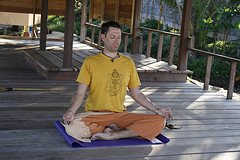
Yoga and Meditation helps greatly in keeping one's Bp under control who are
suffering from Blood pressure/hypertension. Doctor's suggest walking is the best
exercise for BP patient. However, besides walking one can practice certain
simple yoga exercises such as bend your body and touch your toe; strech your
body in both ways, rotate your arms both clockwise and anti clockwise, Lie down
and lift both your legs to certain high level position, touch your toes in a
sitting position bending your body keeping your legs straight etc. These are
minor and warm-up like yoga exercises, one can practice easily on daily basis.
These exercises may be helpful to those who don't have enough time during
morning or in the evening hours for other yoga exercises and walking.
After certain easy exercises and after bathing one can try to practice
meditation for 10 to 15 minutes focusing their concentration on one point or
object .During such Meditation one can chant OM or any other blissful words such
as OM SHANTI ETC.
Daily practice of such exercises and Meditation will help in maintaining your
blood pressure and hypertension to normal level.
Stress Management Yoga Postures
Hatha yoga is the best type of yoga posture for stress management and to get
relief from hyper tension. This is also a easy yoga to eliminate tension and is
the best of all yoga execises for high blood pressure. The best yoga hathasasans
therapy for hypertension are:
- Balasana also know as Child's Pose
- Savasana also know as Corpse Pose or Dead body pose
- Makarasana know as Crocodile Pose
Balasana Instructions for Stress Management:
Balasana is one of the best known Yoga relaxation and meditation which has
helped many get maximum relief from hypertension leading to high blood pressure.
Balasana is also one of the best yoga for hypertension.
Procedure to perform Balasana:
- With your lower legs on the floor, bend your knees
- Now rest your cheast on your knees and stretch your head forward towards
the ground (let your forehead touch the ground if possible)
- Stretch your arms forward or backwards as show in the image
Stay in this pose for about five to six minutes while taking deep breaths.
Savasana Instructions:
The following steps instruct you on how to perform savasana. 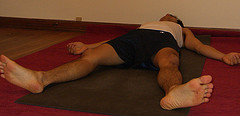
Procedure to perform Savasana Yoga for Hypertension:
- Lie on your back and spread your arms and legs to aout 45 degrees. You can
make use of a yoga mat to make yourself comfortable
- Start to breath deeply letting your body rise and fall with each breath.
Following the pranayama technique of breathing
- Concentrate on each part of your body from head to toe and try to remove
tension from these parts by relaxing
- Stay in this position for about 10 to 15 minutes
Makarasana Yoga Instructions for Hypertension:
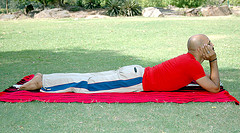 Makar means crocodile and hence this yoga asana is also know as the crocodile
pose. This is one of the best yoga poses for stress.
Makar means crocodile and hence this yoga asana is also know as the crocodile
pose. This is one of the best yoga poses for stress.
- As shown in the picture stretch out your legs and lie down on your stomach
- Hold your head with both your palms with the elbows rested on the floor
Continue deep breating and stay in this position for around five to ten minutes
before getting up slowly. How this yoga reduces stress is by relaxing your
entire body from head to toe.
_____________________________________________________________________________________________________________-
Diabetes is a disease that results when the body does not produce sufficient
hormones to break down the sugar that is ingested. This is a deficiency of the
pancreas which normally produces a hormone called insulin. This hormone helps
regulating the sugar in the blood by converting it into energy. When the
insulin is not sufficient and the sugar does not get converted, it get
accumulated in the blood causing a number of symptoms such as fatigue, unusual
thirst, excessive urination, loss of weight and if it is not treated can cause
coma and death.
Yoga and diabetes
Yoga is an ancient method of exercising body and mind for maintaining all its
functions at their optimum level. Almost all the diseases known to man can be
addressed by yoga – and diabetes can be controlled by it as well. There are
many postures and breathing exercises in yoga which would induce the pancreas
to produce enough insulin to regulate the sugar in the body. These asanas
(postures) not only repairs the pancreatic cell but also induce them to
secrete insulin. Some of the asanas that have proved beneficial for
controlling and reversing diabetes are briefly described below:
Caution: Please do not attempt any of the asanas on your own
unless you have been guided by a yoga guru or certified teacher. Practicing
any of these postures in a wrong way can be detrimental to your health.
1. Pachimotasana (Forward Seated Bend posture) – this is a
posture which promotes the function of the pancreas, liver and the kidneys.
You will have to start by sitting on a mat with your legs stretched in front
of you. Take in a deep breath. Then, slowly bend forward exhaling placing your
head on your knees and reaching for your toes. Touch your toes and keep this
posture for 2-3 breaths then return to the sitting position. This asana should
be repeated two or three times.
2. Mayuryasana (Peacock posture) – this postures helps in
digestion and tones up the liver, kidneys and the pancreas. Though this
posture looks a little difficult with a little practice it can be mastered by
most people. You will need to start by lying face down on your mat. Put your
palms at your sides facing forward and then lift your whole body off the
ground keeping it completely parallel to the ground.
3. Shalabhasana (Locus posture) – this posture is
especially effective for treating acidity and indigestion. In combination with
the other two asanas it helps the digestive system and support the liver and
the pancreas toning up. You will need to start face down on your mat. Ensure
that your feet are together. You would need to lift your legs off he floor
from this position while inhaling. Close your hands into fists at the side of
the body and use them for leverage while you lift your legs. Keep your legs in
the air for a few seconds and then put them down. Relax and repeat 2-3 times.
These three posture are extremely beneficial and can be further complemented
by Bahya Pranayama or external Kumbakha (retention of breath). What you have
to do is very simple. Sit in the normal cross-legged position for yoga. Close
your right nostril and breathe in counting 3; then close your left nostril and
exhale through the right nostril. Now count 12 before you inhale again. This
is very simple to do yet it is very powerful in regulating the energy flow in
the body and expelling the toxins from the body
_________________________________________________________________________________________________________________
- Yoga
Exercises for weight loss
-
Yoga has proved beneficial in many, many afflictions of the human body –
both mental and physical. It is universally accepted that yoga is highly
beneficial in controlling and reversing many diseases. However, people are
divided on whether or not yoga helps with weight loss
Does Yoga Help With Weight Loss?
Yoga is a combination of a set of physical and breathing exercises coupled
with meditation. Each set of exercises are meant to address certain
problems in the body and most people practice only those which they need.
This could be controlling of blood pressure, hypertension, diabetes,
depression, arthritis, asthma, digestion and so on. You name it, and yoga
has a remedy for it.
What is weight gain?
The body gains weight when the metabolic rate is unable to use the calorie
intake and hence the excess is turned into fat deposits on the body. The
excess calories are usually consumed by strenuous exercises or eliminated
altogether through dieting. Yoga is not strenuous; however, it can
increase the rate of metabolism so the body burns more calories than it
normally does. In this manner yoga can regulate the fat deposits and
induce weight loss without sweating through hours of strenuous aerobics or
weight-training in the gym The plus point of using yoga for weight loss is
that besides the fact that you control weight gain and burn more calories
than you would normally do (and hence loose weight), it also provides you
with an opportunity to meditate. Meditation along with the yoga asanas for
weight loss brings about not only the required reduction in your weight
but also reduction of in the levels of stress.
Yoga can help you reduce hunger and control those binges that most
overweight people fall prey to in between diet programs. Hence, yoga
impacts the body through many ways – (i) increases the metabolic rate so
more calories are burnt, (ii) reduces appetite and controls hunger, (iii)
checks compulsive overeating habits and lastly (iv) relieves stress which
many times is one of the main reasons for gaining weight in the first
place.
Looking at the above, one can deduce that indeed yoga can help in reducing
weight – though not in the way one would think exercises usually help.
Yoga is very different from other physical fitness exercises and according
to millions across the globe who diligently practice this system, it
works. Done correctly, yoga is known to be able to tackle the worst of
afflictions.
Yoga for Fat and Obese People
If you are fat or obese the best type of yoga for you is the Vinyasa style
of yoga. This style of yoga is mainly a set of sun salutations that
includes athletic yoga styles. The following types of yoga are considered
best for weight loss:
Power Yoga for Obese:
Power Yoga offers you with a vigorous cardiovascular workout which helps
your body regulate weight. Power yoga is considered to be very effective
when it comes to weight loss for obese people.
Bikram Yoga or Hot Yoga :
The second type of yoga for obese people is the Bikram yoga otherwise
known as hot yoga. The
26 different
poses of Bikram Yoga can help you loose weight with ease.
If you think you are very obese or fat then the best way to beign is by
going for some simple yoga poses and then moving on to the more advanced
poses.
There are a few things that you need to take care about when you do yoga
– the first and foremost is that you need to learn the asanas or
postures from a qualified and certified yoga practitioner. The postures
should be done correctly or your health would be harmed rather than
helped. Then, you would have to do it everyday even if it is for just
15-20 minutes or it would loose its efficacy. As long as you do yoga in
the right way, you would definitely profit from it – in whatever way you
want – not only for weight loss.
_______________________________________________________________________________________________________
A lot has been said about the 26 poses of Bikram Yoga and from the reports
found all over the Internet, it looks like it is quite popular all over
USA and many other places in the world. Bikram Yoga is not a special
branch of yoga. Rather it is a set of twenty-six specific postures or
asanas which need to be performed in a certain sequence in an environment
that is pre-heated to 40.5 degrees.
The whole exercise takes about 90 minutes and it has to be done every day
– in return Bikram yoga claims it would keep you as healthy as it comes.
The Bikram Yoga is special in the fact that it is copyrighted to Bikram
Choudhury, a person who has been giving yoga classes since he was 20 years
old.
Bikram wrote a book on the way he thought that yoga could be used for
maximum benefit - Bikram’s Beginning Yoga Class for which he obtained
copyright in 1979. Ever since, he had demanded that anyone who taught his
style of yoga should apply for a license from him – as Bikram Yoga had
become copyrighted style of yoga. In 2002 a court in USA granted him this
right and ever since Bikram Yoga has been a style or method of yoga that
intellectually belonged to Bikram.
What Are The 26 Poses Of Bikram Yoga
There are plenty of ways in which you could learn abou Bikram Yoga
postures. Youculd use the book, the video cassette or DVD and self tutor
yourself with the help of the material you buy. However, the best is to
learn it in a Bikram Yoga (licensed) center as you could be guided
carefully into mastering the whole set of 26 postures.
Bkram claims that he had chosen these 26 postures in such a manner that
the person who practices them would be able to exercise each and every
muscle, tendon, organ and even bone and skin once he/ she completes the
whole set. The postures should always be performed in the sequence given;
it is important that the sequence be maintained as this too has been
chosen to optimize the impact it has on the body as well as gradually
increase the capacity of the body to perform. The sequence of the 26
postures of Bikram Yoga is as follows: 12. Padangustasana – 13. Savasana
– 14. Pavanamuktasana – 15. Sit-up – 16. Bhujangasana – 17.
Salabhasana – 18. Poorna Salabhasana – 19. Dhanurasana – 20. Supta
Vajrasana – 21. Ardha Kurmasana – 22. Ustrasana - 23. Sasangasana –
this is also known as the Rabbit Posture and as its name indicates it
resembles a standing rabbit.
Padahastasana
This is the Standing Deep Breathing posture which helps warming up the
body before the whole set of yoga postures are practiced
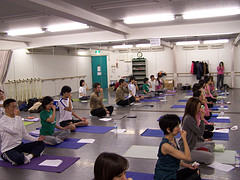
Ardha Chandrasana
This is also known as the Half Moon Pose with Hands To Feet Posture and it
flows the warming up session.
Utkatasana Bikram Yoga Pose
this is the third posture and it is also known as the Awkward Posture
because it is looking like you are half sitting half standing up – and
it looks and feels awkward.
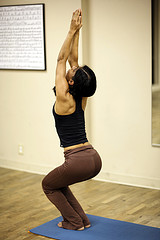
Eagle Pose of Bikram Yoga
the fourth bikram yoga posture is called the Eagle Pose and it imitates
the way an eagle stands on earth.

Dandayamana - JanuShirasana
The fifth bikram yoga pose involves a Standing Head To Knee Pose, which is
a little difficult to do without professional (initial) help
Dandayamana - Dhanurasana
This is a very challenging posture, also known as the Standing Bow Pulling
Pose – the sixth of the string of 26 total postures of Bikram yoga.
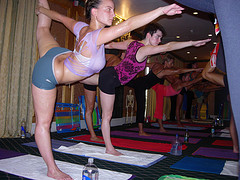
Tuladandasana
The seventh of the bikram yoga postures is the Balancing Stick Posture
which is named so because it looks like you are a stick for balancing.
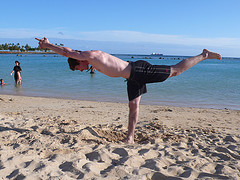
Dandayamana - Bibhaktapada - Paschimottanasana
The eight one is known as the Standing Separate Leg Stretching Posture and
it involves deep stretching on each of your legs.
Trikanasana
The ninth posture involves your body taking the shape of a triangle and
hence it is called the Triangle Posture
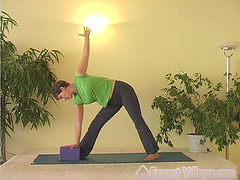
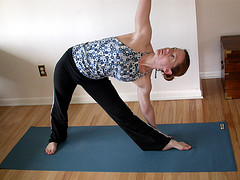
Dandayamana - Bibhaktapada - Janushirasana
The tenth bikram yoga is also known as the Standing Separate Leg Head To
Knee Pose as it involves stretching and bending to each knee.
Tadasana
In the eleventh posture you would take the shape of a tree and hence, this
is called as the Tree Pose.
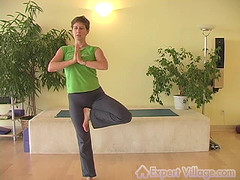

Padangustasana
the twelfth asana or posture is known as the Toe Stand Pose - a
complicated posture for beginners, but quite easy to accomplish once you
know how.
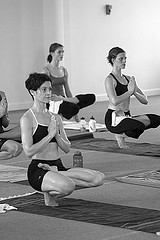
Savasana or Dead Body Pose of Bikram Yoga
Sav means a dead body and hence this bikram yoga asana is known as the
dead body pose. In this posture (the thirteenth) your whole body relaxes
as if you were dead.

Pavanamuktasana
'Pavan' means 'wind' and 'mukt' means 'free'. As this bikram yogasana
helps you revome gas from within the body it is known as the 'wind
removing pose'.
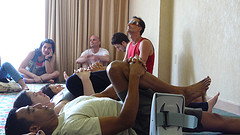
Sit up Yoga Pose
This posture is may be the simplest of all – after the
dead-body-posture. It involves sitting up.
Bhujangasana Pose
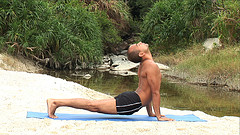

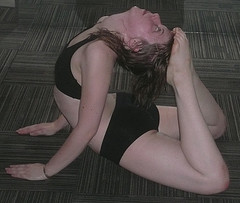
Bhujang means cobra and hence this pose is also called the cobra pose. In
this yoga posture, the sixteenth one, you imitate the way a cobra snake
stands before it attacks – hence it is known as the Cobra Posture.
Salabhasana
This posture is also known as the Locust Posture because it imitates the
way a locust stands.
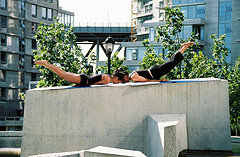
Salabh means locust and this asana is known as the locust pose
Poorna - Salabhasana
The eighteenth posture of Bikram yoga is also known as the Full Locust
Pose.
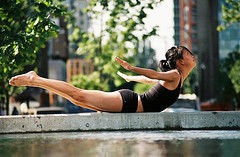
Dhanurasana
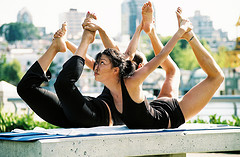

Dhanush mean Bow and hence this asana is called the Bow Pose.
Supta - Vajrasana
the twentieth pose of bikram yoga, the Fixed Firm Pose is easy to
accomplish and repares the body for the next in the series, i.e. the
half-tortoise-pose.
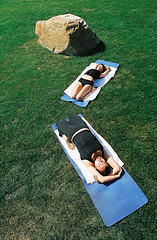
Ardha - Kurmasana
This is the twenty-first posture and it imitates the way a tortoise looks;
hence it is called the Half Tortoise Pose
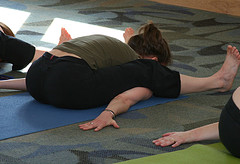
Ustrasana
Ustr mean camel. The next posture is the Camel Pose where your body is
shaped to look like a camel.
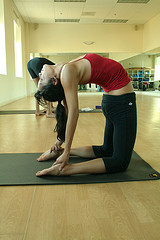
![]()
Sasangasana
In sanskrit, sasang means the rabbit and hence this pose is known as the
rabbit pose

Janushirasana with Paschimottanasan
the twenty-fourth posture involves stretching again and describing what it
involves, it is called the Head To Knee Pose with Stretching Posture
Ardha - Matsyendrasana
This is one of the most efficient and yet one of the most dangerous
postures (if done incorrectly). The Spine Twisting Posture is the
twenty-fifth of the whole set of Bikram Yoga.
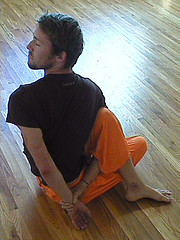
Khapalbhati
The last of the Bikram yoga set is the Blowing In Firm posture, which is
also a relaxing posture.
So these are the 26 different poses of Bikram Yoga also known as hot yoga.
All these postures have to be done twice before going to the next posture
and the whole set should take about 90 minutes from end to end.
In order to become a certified instructor a person would need to
successfully complete a specially designed training course which is
spanned over a period of two months. The successful candidate would then
be awarded a certification by which he/ she would be recognized as a
certified Bikram Yoga teacher.
You will find that Bikram yoga is also called the ‘hot yoga’ - owing
to the fact that it is practiced in a pre-heated room. The reason for this
aspect of Bikram Yoga is that heat helps the body’s flexibility and at
the same eliminates toxins faster – hence all the 26 postures of Bikram
yoga are usually practiced in a pre-heated room which has mirrored walls
to help the person see the way they perform and hence practice their
postures to perfection.
Bikram claims that if the Bikram Yoga series is practiced the way he
taught it, the person would never suffer from any ailment during his/ her
life. Yoga has the power of regulating all body functions as well as
voluntary and involuntary reflexes. The particular sequence that Bikram
has worked ensures that the body is maintained in top form no matter what
age the regime is practiced.
______________________________________________________________________________________________________
-
Yoga is an very ancient method of exercising your body and mind towards
achieving complete internal and external balance and health. The exercises
unlike the ones you are used to do in a gym, are not strenuous; rather
they are all about bringing the body into certain postures called asanas.
Each of these postures affect one or other part of the body coaxing it
into performing optimally and hence removing any malfunctioning causes.
Yoga And Menstruation Pain Relief
Yoga has an answer for any type of ailment that human beings suffer from.
Some are easy and some not so easy – however, if these asanas are done
correctly and regularly, the cure from the diseases is completely
guaranteed. When it comes to menstruation, yoga can and has remedy. The
asanas that help relieving the pain have to be done before or after the
menstrual cycle as yoga is rarely practiced during menstruation. Some of
the postures that can bring relief are briefly discussed below:
1. Standing yoga postures – there are postures that are
required to be done standing such as the Trikonasana (Triangle posture)
with its variations called Pavritta trikonasana and Utthita parvakonasana
are extremely helpful. These postures increase the flow of the blood in
the lower abdomen and massage the reproductive organs removing all cases
of malfunction and hence relieving the pain.
2. Sitting yoga postures – the standing postures can be
complemented further by the sitting style postures such as Bhada Konasana
(Large Angle), the Malasana (Garland Posture) and the Kurmasana (Tortoise
Posture) which relax the massage the lower back muscles while at the same
time help in the toning of the muscles of the lower abdomen. Especially
beneficial for menstrual spasms and menstrual cramps is the Suptabada
Konasana which also helps in relieving the burning sensation associated
with urinary infections.
Then there is the Vajrasana which concentrates on the pelvic muscles and
immediately upwards muscles. Besides strengthening these muscles, it also
brings about a calming effect. This is good when the pain is due to the
malfunctioning of the ovary and the other reproductive organs.
Complementing this posture are the cat posture which is called that way
because it involves a complete arching of the back very similar to what
cats do when challenged by some danger. This prevents menstrual disorders
and corrects the position of the uterus.
The cat posture can be followed by the dog posture and then to the camel
postures – which aim at toning the back muscles and strengthening of the
reproductive organs. These postures push the blood into the pelvic region
and thereby release the tension over the area.
Another posture that you could do while sitting is the Ardha
Matsyaendrasana (Half-Spinal Twist) which tones the uterine muscles and
relieves the pain during menstruation.
3. Bending yoga postures – though pending postures are
not advisable during periods, some can help relieve the pain if done
moderately. For example, the Chakarasana (Wheel posture) and the
Dhanuranasana (Bow posture) should never be done while the periods are on
– but if practiced before it can combat some of the pre-menstrual
symptoms such as irritation and depression.
In this manner you could choose and practice some of the yoga postures
depending upon what exactly is your problem, and enjoy total relief from
menstruation pain.
_____________________________________________________________________________________________________________
-
Well yoga has an answer for almost every ailment known to human beings;
however, in order to take care of everything, you need to perform the
postures correctly and with unfailing regularity. There are many chronic
ailments that the allopathic medicines do not have the right answers for.
More and more people are looking for alternative medication and processes
of healing and yoga is growing in popularity every day across the globe.
Can Yoga Help You Grow Taller?
Well, the answer is both ‘Yes’ and ‘No’. There is a perfectly
logical explanation for this. This is because yoga improves your posture,
it frees your spinal cord from tension and your muscles and ligaments
become aligned properly – as they are supposed to be. This results into
a perfect body alignment, which enhances by a correct posture makes you
taller.
This is not because you grow any taller; rather it is because it makes
your body stand taller through facilitating its correct posture. The yoga
frees not only your spinal column from all the unnecessary (and most
imperceptible) twists and contractions, but also promotes more flexibility
of the body overall. In this way very often people feel better and look
better. Therefore, many think that yoga does indeed help in growing
taller.
There is one thing with yoga though. In order to enjoy its benefits in
full, you would have to practice it daily without fail. This is not a
regime that you could undergo anytime you like, whenever you like. The
best time to practice yoga is in fact the sunrise time. Yogis believe that
the early morning sunrays and air are highly beneficial for the body and
mind and hence when one does yoga at this time, the impact is optimal.
Some of the major benefits you could receive from yoga besides healing of
numerous diseases and ailments are as follows:
- Body balance and complete muscle workout and relaxation
- Correct any imbalance, strengthens the skeletal system with emphasis
on the spinal cord
- Lubricates joints and ligaments (for which arthritis pain can be
relieved to a great extent) enabling better movement of limbs/ joints
- Balances your inner energy and pacifies your mind promoting higher
concentration and memory power
- Aligns knee joints to perfection
- Improves mood, confidence levels and self esteem
- Massages and promotes the correct functionality of each and every
organ inside and outside the body
- Increases both mental and physical stamina by renewing the inner
energy of the body
- Improves sleep and capacity to relax
- Brings discipline in one life – both mental and physical
To sum up, yoga is a great system of exercises which can benefit you in
more ways than you would think possible. However, yoga cannot help you in
height growth, in other words yoga cannot make you grow tall. On the other
hand it would help in aligning your body optimally so through your correct
posture and body movements you would look taller than you were before you
practiced yoga.
_____________________________________________________________________________________________________--
-
Yoga science of breathing is called prayanama. Oxygen is the most vial
nutrient to our body. It is essential for the integrity of the brain,
nerves, glands and internal organs. We can do without food for weeks and
without water for days, but without oxygen; we will die within a few
minutes.
Where to Perform Pranayama yoga
Pranayama techniques are best practiced while sitting on the floor on a
folded blanket. This form of practice is applicable to padmasana also.
However; any other posture will do provided the back is kept erect from
the base of the spine to the neck and perpendicular to the floor. Bad and
poorly performed posture will lead to shallow breathing and low endurance.
One must empty the bladder and bowels before starting pranayama yoga.
When to Perform Pranayama
Pranayama yoga must be performed in empty stomach. The best time for
practice is the early morning, preferably before sunrise when the
pollution is at its lowest level, and the body and brain are still free.
However, if morning is unsuitable, pranayama may be practiced after
sunset, when the air is cool and pleasant. The place suitable for all
kinds of Yoga must be clean and calm.
Major Types of Pranayama and Instructions
There are five major types of pranayama yoga are as follows:

- Nadi Sodhana
- Shitali Pranayama
- Ujjayi Pranayama
- Kapalabhati Pranayama
- Digra Pranayama
Nadi Sodhana:
Following steps instruct on how to perfrom the nadi sodhana pranayama:
- Sit down in a comfortable place assuming a cross legged position
- Now use your thumb (right hand) to close the right side of your
nose. Inhale deeply using the left nostril
- Now close the left nostril and exhale using the right one
- In the same way, now with the left nostril still closed, inhale
using the right nostril and exhale with the left one
You can continue doing this exercise for around 10 - 15 times.
Shitali Pranayama:
Sheetal also means cool, and this pranayama technique will help you
achieve the same. To perform shitali pranayama, be seated in a comfortable
position. Cross your legs and take five to six deep breaths to get
yourself prepared.
Now open your mouth in a "o" shape and start to inhale through
the mouth. When you exhale, do so with your nose.
This can be repeated five to ten times.
Ujjayi Pranayama
Ujjayi means the ocean and this pranayama is about mimicking the oceanic
sound or the sound of the waves.
To do this, be seated in a comfortable position crossing your legs. Now
start to inhale and exhale deeply using your mouth.
While doing this, constrict your throat as if something is choaking it
when you exhale and inhale the air. This will produce a sound similar to
the ocean when you breath.
Now close your mouth and start to breath using your nose, but maintain the
same tone to your throat so you still continue to make the same sound as
your breath.
You can repeat this prayanama breathing exercise for about ten to fifteen
times.
Kapalabhati Pranayama:
To perform the kapalabhati pranayama technique, sit in a comfortable
position crossing your legs. Perform two to three deep inhales and
exhales.
Now inhale deeply and exhale forcefully drawing all the air out. Your
belly should be drawn in, as you exhale.
When you inhale, let it happen passively without you making any effort to
inhale as the belly goes back to normal position.
Exhale forcefully again and continue doing this for about 20 to 30 times.
Dirga Pranayama - Three Part Breathing
The dirga pranayam is a bit different from other types as it involves
lying down on your back instead of being in a seated position. This
technique involves very deep inhalation and exhalation.
To perform this panayama, lie down on your back and close your eyes.
Breath normally and then slowly take deep breaths, relaxing your body.
Now inhale a lot of air in slowly to fill your belly up. Your belly should
rise up like a balloon. Hold this position for a few seconds and exhale
drawing the belly inwards ensure there is no air left.
In the second step, inhale deeply to fill up the belly. Inhale a bit more
to fill up air in your rib cage. When you exhale, exhale air from your rib
cage and then from your belly.
In the third step, inhale deeply to fill up your belly and rib cage with
air. Inhale a bit more to fill up your heart center (area around the
heart) with air. When you exhale, exhale air from the heart center, then
the rib cage and then the belly.
Repeat the whole process for five to six times
Viloma Pranayama
VILOMA Pranayama involves praused breathing at regular intervals and can
be divided into two stages. The first stage is called 'paused inhalation'
and the second stage is called 'paused exhalation'. Let's look at these
stages in detail:
Viloma Paused Inhalation:
- Lie down in a comfortable position and try to relax. Breath deeply,
but normally
- Now inhale for 2 to 3 seconds and pause. Hold your breath for two
seconds and then restart inhalation. Pause inhalation again after 2 to
seconds. Inhale again. Repeat this process untill the lungs feel full
of air
- Exhale now, slowly, till you feel empty of air
Viloma Paused Exhalation: The paused exhalation is the
exact opposite of the inhalation process. In this case, you inhale deeply
and normally without interuption, but exhale with regular pauses.
Anuloma Pranayama
Just like Viloma Anuloma is about alternate nostril breathing. In this
case, the inhalation and exhalation is done with one nostril blocked and
the other partially open. Some variations of the yoga are granular anuloma.
This type of pranayama is particularly useful in clensing the nasal
passages and creating calmness within.
What is the Importance of Pranayama?
Practice of pranayama yoga has been reported to be beneficial in treating
a range of stress related disorders, improving autonomic functions,
relieving symptoms of
asthma,
stuttering and reducing signs of oxidative stress. Pranayama techniques
are also effective for depression cure. Practice of prayanama develops a
steady mind, strong will-power and sound judgment. In addition regular
pranayama helps extends life and enhance perception
In old age, the respiratory function decreases due to the contraction of
the air cells of the lungs, which therey takes in less oxygen. Prayanama
will help to normalize their size and make the red corpuscles circulate in
all parts of the body, infusing life and vigor throughout. Through regular
practice even old people can delay the ageing process.
____________________________________________________________________________________________________________
-
Yoga in sleep mode or Yoga Nidra means psychic sleep. This kind of
psychic sleep helps remove physical, emotional and mental strains
very easily and in an effective manner. It also helps focus the mind
and remove negative elements.
This can be practiced either during morning after bathing or in the
evening after sunset.To perform this psychic sleep, one may spread a
bed sheet and lie on it closing both eyes, Concentrating on one
point or object for 15/20 mnts. One can also focus his/her attention
from feet and move slowly to knees,thigh,stomach,chest ,hands,face,eyes,ears
and finally to head. Keep repeating this process for 15 to 20 mnts.
One should not sleep during this process of Yoga Nidra but remain
fully focused on certain point or object.
This Yoga Nidra is easy to practice and helps in maintaining blood
pressure, stress related problems etc.
Procedure to Perform Yoga Nidra Meditation
Before you start to perform yoga nidra meditation, make sure that
you are in a silent atmosphere. Put on dim lights and lie down with
your back touching the floor. You can lie on a yoga mat if that
makes you feel comfortable.
Take deep breaths and try to concetrate on the center of your
forehead between the eyes. Don't try too hard to concentrate. Begin
first by concentraing on your breath before moving over to the
forehead. You need to talk deep breath initially and then back to
normal.
Yoga nidra also know as the yoga sleeping technique will take you to
a very deep level of relaxation. Bringing your body back to normal
state instantly is not advisable as it might shock some people. So
make it 100% sure that your surroundings are disturbance free. Bring
your body back to normal by practing the breating technique.
The yoga nidra technique can help you relax and get in touch with
your subconscious mind. With constant practise you will begin to
better understand yourself. The best way to being yoga nidra
technique is by first becoming an expert in the savasana technique
of yoga.
_________________________________________________________________________________________________________
-
Human emotions can cause the body's digestive system to suffer a
variety of ailments from diarrhea to bleeding ulcers. Yoga for digestion
issues will help to enhance the ability of the stomach and intestines to
process and to absorb food while drawing off excess acid and gas and
stimulating the production of protective mucous secretions.
A program of yoga for digestion should be undertaken in consultation with
your personal physician and under the tutelage of a qualified yoga
instructor. Unlike the casual classes health clubs offer as a low-impact
exercise option, the targeted use of yoga for specific health problems
requires the precise selection of positions and the correct performance of
the moves, often in a particular sequence. Breathing, pace, and balance
are all important.
Expect a yoga for digestion regimen that will focus on back bends that
serve to:
- increase gastrointestinal circulation
- promote healing
- increase food absorption
- reduce acid
- increase mucous production
- decrease gas
Many of these positions will stimulate the vagus nerve, which starts at
the brain stem and runs down the neck and chest to the abdomen. Proper
yoga massage of this nerve will have the added benefit of lowering heart
rate and blood pressure as well as settling stomach and intestinal
distress and discomfort. As a good illustration of why it's important to
work with a professional yoga instructor, however, if the vagus nerve is
stimulated with forward bends, it will actually send more not less acid to
the stomach. (There are also some inversion positions that work on the
vagus nerve, but the moves are advanced and are not appropriate for
beginning practitioners.)
Since many digestive complaints are intimately related to a case of
"the nerves," for instance fear of attending or participating in
an event or meeting or being unable to eat due to emotional distress, any
yoga for digestion routine will also concentrate on calming the mind and
equipping the student with stress-reducing techniques. These may range
from breath training and control to subtle muscle flexes that can be
performed anywhere to reduce stress. An effective breathing exercise that
can calm a nervous stomach is called Alternate Nostril Breathing:
- Pinch your nose so that the nostrils are closed.
- Hold your breath for a count of 2 to 5.
- Release the right nostril and exhale, then inhale.
- Repeat for the opposite nostril.
- Work through a total of 20 breaths.
All yoga work involves cultivating the ability to detach and to control or
to mitigate negative physical and emotional reactions. Since these
reactions often manifest in the digestive tract, yoga for digestion issues
is a natural fit.
The rate and frequency of yoga practice will depend on the nature of the
complaint. In cases of indigestion, for instance, regular yoga practice
promotes more routine bowel patterns and prevents the backing up of acid
into the stomach. It is perfectly acceptable to practice any yoga routine
daily, with the minimum requirement being two to three times a week. Most
practitioners simply gauge the degree of relief they are receiving and
time their yoga sessions accordingly. Since yoga for digestion has a high
rate of success, practitioners tend to do more than less for the comfort
they are afforded
________________________________________________________________________________________________________
-
Although often perceived as simply an exercise regimen to increase
flexibility, yoga poses for stomach ulcers and other gastrointestinal
disorders has proven to yield a high rate of success. Practitioners who
carry their understanding of yoga beyond the obvious physical benefits
understand that the discipline has a number of more subtle,
"hidden" effects on the overall system including:
- massage of the internal organs
- improved glandular function
- decreased acid production
- mental control and calm
Since no bodily system is more intimately tied to the individual's
emotional state than digestion, it should not be surprising that yoga for
ulcers is a viable treatment and maintenance option.
As with any program of exercise, it is advisable to consult with your
physician before beginning. Next you will want to find a qualified
instructor who will help you to develop a yoga routine designed to deliver
maximum gastrointestinal benefit. Since you will want a program of
stretches and poses that specifically stimulate key organs and nerves, the
assistance of a trained master is essential. It is good, however, to
understand the basic goals you are trying to achieve in a program of yoga
for ulcers as you go into your meeting with your new coach.
First understand that your yoga regimen should emphasize back bends that
stimulate the circulation of blood in the gastric area and in the process
promote healing of the ulcer. These positions will also improve the
stomach's ability to process and to absorb food while enhancing the
secretion of mucous by the glands to coat and protect the sensitive lining
of the stomach. (Be honest with your yoga instructor about any issues you
have with your back, since you do not want to aggravate one problem will
addressing another.)
To reduce acid flow to the stomach, the stretches chosen must stimulate
the vagus nerve, but be cautious about forward bends which are to be
avoided as they have exactly the opposite effect. People with sufficient
flexibility will also benefit from inversions that further aid in food
absorption with the added benefit of removing excess gas from the system.
These are, however, advanced moves and not appropriate for the beginner.
While back bends address specific factors contributing to the healing of
the existing ulcer and the prevention of future flare ups, the overall
yoga routine should be one that allows the individual to cultivate a
quieter mind. Carrying a better sense of mental and emotional control into
daily life will allow the person to release habits and reactions that
caused the ulcer to erupt in the first place. Mental and emotional goals
of a program of yoga for ulcers include:
- cultivating emotional detachment under stress
- releasing the quest for perfectionism
- establishing peaceful and regular sleep patterns
In addition, the ulcer sufferer would do well to adhere to strict and
regular meal times with a selection of foods that will not aggravate the
existing irritation in the stomach. By practicing carefully selected yoga
poses that benefit both the body and the mind, it is possible to use yoga
for ulcers as both a treatment and an important preventative measure.
_________________________________________________________________________________________________________
Chakra Meditation Technique to Open Third Eye
The Ajna chakra is positioned at the eyebrow
region and it has two petals,
said to represent the psychic channels
Ida and Pingala, which meet here with the central Shushumna channel before
rising to the crown chakra, Sahasrara.
On the left hand petal is the letter 'ham', and on the right the letter 'ksham',
the bija mantras for Shiva
and Shakti
respectively.
Ajna is considered the chakra of the mind. When something is seen in the mind's
eye, or in a dream, it is being 'seen' by Ajna.
Residing in the chakra is the deity
Ardhanarishvara
a hermaphrodite form of Shiva-Shakti,
symbolising the primordial duality of subject and object, and the deity Hakini
Shakti is
also present in this chakra.[citation
needed]
In kundalini
yoga, different practices are said to stimulate the Ajna chakra,
including Trataka
(steady gazing), Shambhavi
Mudra (gazing
at the space between the eyebrows), and some forms of Pranayama
(breath exercises).
Guided Meditation Technique
Background of Ajna Chakra Meditation Technique
(Third Eye):
The Ajna Chakra is the sixth chakra of the Kundalini
Seven Chakra System. A chakra is an energy vortex which resides in
a particular location of the body and governs the organs and glands of that
region. A Chakra is also associated with certain traits and
characteristics of the personality and forms a bridge between mind, body and
spirit.
The Ajna Chakra (or Third Eye) eye lies at the very
top of spine in the medulla oblongata. It relates to the pituitary
gland, the pineal gland, the nasociliary nerve plexus and frontal lobes of
the brain.
Chakra
Meditation means to activate and balance a particular chakra, thus
improving the functioning of everything in that particular region as well as
refining the associated personality traits and characteristics. In
some cases psychic
powers associated with a particular chakra are also unleashed.
Ajna Chakra literally mean “To Command”.
This chakra is also called the “Third Eye” as it’s activation gives
one the power of intuitive knowledge. In addition, it is called the
“Guru Chakra” as its activation connects one to the “Inner Guru”.
Similarly, it is also called “Eye of Shiva” or “The Divine Eye” for
it’s awakening implies the higher stages of meditation and wisdom.
Each chakra can be activated by several means.
In this guided meditation we will use the physical trigger point of the
chakra (kshetram) as a point of concentration to activate it. In
addition, each chakra is associated with a particular seed sound (Beej
Mantra) which can be utilized to awaken it. For the Ajan Chakra
the Beej Mantra is the primordial sound “OM” (AUM) and this guided
meditation will be using that as well.
Tools required for Ajna Chakra Meditation Technique
(Third Eye):
- An alarm clock, stop watch or other time device.
Benefits of Ajna Chakra Meditation Technique (Third
Eye):
Primary Benefits:
- Builds the power of intuition.
- Bestows and increases Psychic Powers.
- Increases and refines awareness.
- Provides clarity of thought, insights
and wisdom.
- Allows one to connect to the “inner
guru” or “higher self” for guidance and inspiration.
- Builds the Yogic Mind or Neutral Mind
which is free from attachments of the ego.
- Build the power to read others and
detect their subtle and gross energetic conditions.
- Promotes flow of Kundalini
Energy into the higher centers.
Secondary Benefits:
- Promotes the ability to have Lucid
Dreams.
- Allows for non-verbal communication.
- Builds focus and one pointedness of the
mind.
- Improves your vision.
- Promotes health and wellbeing.
Cautions for Practicing Ajna Chakra Meditation
Technique (Third Eye):
Do not strain when holding shambhavi yoga
mudra (detailed below).
Guided Ajna Chakra Meditation Technique (Third
Eye):
Follow the step by step guided meditation below to
practice this technique:
- Sit in a comfortable cross legged position.
You may also sit on a chair or lean against a wall for this meditation.
- Set your alarm or other time device for 20
minutes.
- Elongate your spine upwards, lengthen your neck
and subtly bring your chin back and in, like a soldier at attention.
This will align the spine with the back of your head.
- Take 5 deep, slow breaths though the nose.
This will oxygenate your blood and relax you.
- Keeping the head straight look up at an imaginary
point in the middle of your forehead, just above the eyebrows.
This eye position is called shambhavi yoga mudra. Close your eyes
while holding this mudra. Do not strain excessively.
- Rest your hands in any comfortable position, you
can place them on your knees.
- Try to remain as still as possible.
- Now inhale deeply and begin to chant in a soft,
slow, steady voice the manta OM (pronounced AUM). One chant of OM
(AUM) Mantra should last for the entire exhalation. Its a long
“Oh”, followed by a semi long “Mmmm” during each exhalation.
Once all the air has been expelled, inhale fully again and begin to
chant the mantra once more. Visualize the OM sound coming from a
point in the middle of the forehead just above the eyebrows and
emanating throughout your entire body.
- Continue for the duration of the
meditation. If your eyes tire from shambhavi yoga mudra release
the mudra but continue to chant the OM (AUM) mantra as above.
Reapply the mudra again when ready.
- Once you have completed the
meditation, rub the palms of your hands together to make them warm and
place them on your eyes as you open them slowly. This will relax
and comfort your eye muscles.
Hints and Tips for Ajna Chakra Meditation Technique
(Third Eye):
- There are many variations to OM (AUM)
Mantra chanting for the activation of Ajna Chakra. I will provide
a variation that only requires silently chanting OM Mantra and therefore
can be practiced almost anywhere. Follow all steps from the guided
meditation above except instead of chanting OM (AUM) Mantra out loud, as
you inhale chant “Oh” silently, while visualizing the sound flowing
into Ajna Chakra from your forehead and then silently chant “Mmmm”
as you exhale, visualizing the sound leaving your forehead from Ajna
Chakra. The rest is the same as the guided meditation above.
Secret of Ajna Chakra Meditation Technique (Third
Eye):
Many women today are actually practicing Ajna Chakra
Meditation without even knowing it. This is resulting from the
tradition of wearing a bindi. A bindi is the colorful decorative dot
placed in the middle of the forehead and was designed originally to provide
continual stimulation to Ajna Chakra by way of its Kshetram (physical
trigger point). So next time you wear a bindi, remember that not only
does it look oh so fine, but it is also raising your level of awareness and
consciousness - not bad for a dot.
Third Eye - Ajna
Chakra Opening & Balancing Class Objectives:
- Awakens Kundalini Shakti (Energy) and moves it up
to the higher centers.
- Promote Intuition, Insight and Creativity.
- Clears the psychic channels (nadis) of blockages
to increase the flow of prana (life-force) in the energetic body.
- Improves Brain function by increasing both
awareness and intelligence.
- Allows you to connect to your Divine Nature or
Inner Guru.
- Enhances powers of non-verbal communication and
seeing beyond the ordinary mind.
- Balances all the Chakras and brings harmony and
peace to the entire system.
- Develops the Nervous System, Respiratory System
and Digestive System.
- Helps build the power of concentration.
- Enhances ability to have Lucid Dreams.
Third Eye - Ajna
Chakra Opening & Balancing Class Details:
Class Structure:
Each class session consists of 3 sections:
Breathing exercises (pranayama), Kundalini Yoga Kriyas (sets) and Guided
Meditation Practice. The exercises are designed to allow you
to pace yourself, so whether you are a beginner or experienced yogi you will
find the class useful. The total time for this class is approximately
30 minutes / day. Do the best you can and most importantly, walk the
middle path with regard to each session. DO
NOT OVERDO OR OVER STRAIN and at the same time don’t
have it be too easy either.
Required Reading:
10
Important Guidelines to Kundalini Yoga Practice
Legal
Disclaimer
Suggested Reading:
Introduction
to Kundalini Yoga
Kundalini
Yoga Seven Chakra System Overview
Third Eye - Ajna
Chakra Opening & Balancing Course Syllabus:
The following describes the 3 sections comprising
the 30 minute daily yoga and meditation session for this class. The
approximate total times for each section and set are also given. Take
more rest if you need to, or if you feel comfortable do the poses and
exercises a little longer. Each breathing exercise, Kundalini Yoga
Kriya and Guided Meditation technique below is a link to the article with
all the details you need.
Third Eye (Ajna
Chakra) Opening & Balancing Class:
Each day for 1 week do the following…
Breathing Exercises Section (Pranayama):
Total time 5-10 Minutes
Kundalini Yoga Section: Total
time 5-10 minutes
- Kundalini
Awakening Raja Yoga Kriya: 5-10 minutes - Do the Beginners version
and only if comfortable with that move onto the Intermediate or Advanced
versions. This set will channel Kundalini Energy up towards the
higher regions.
Guided Meditation Section:
Total time 5-10 minutes
- Ajna
Chakra Meditation Technique: 5-10 minutes - This meditation
technique uses the power of the Seed Mantra (OM) for the Third Eye
Chakra to open and balance the Chakra.
Third Eye - Ajna
Chakra Opening & Balancing Participation Guidelines
Following are the guidelines which I suggest we
follow…
- Please post all comments, questions and
feedback in the comments section of this post. This way
all will benefit from the discussion. Feel free to ask questions
or discuss issues, as that is one of the main reasons for this
particular class format. Of course, you are free to email me as
well if you would like the discussion to not be public.
- If you like, you can indicate with a comment that
you have completed your daily session. Could be as short as
"did it", or of course could be questions, issues or more
detailed feedback. The hardest part with a daily yoga and
meditation practice is establishing consistency and regularity and I
think having to acknowledge that you completed your daily sadhana
(spiritual work) will help in facilitating that. In addition, your
comments would inspire others as well.
- I will post all information regarding the class
in the comments section below as well, so please check periodically for
updates.
- Before starting your daily yoga and meditation
session, take a moment and tune in to your higher self for guidance and
protection. At the end of every session, visualize yourself and
the world as you would like it to be.
- Do the best you can and modify the class as you
require. It is more important to do something, than be overwhelmed
and not do anything at all.
- I wish you all a wonderful learning and
transforming experience.
Click
here to see video on this meditation in this website
The Right Way to Acquire Psychic Powers
(Yoga Siddhis)
Yoga Sutras of Patanjali: Personal Development & Spiritual Growth
Lately I have been getting many requests with regard
to psychic powers, their acquisition, value, purpose etc. Although I
can’t cover all these aspects in one article, this post will kick off the
series in which I will delve into these topics.
In Yoga terminology psychic powers are called
Siddhis and they are addressed in detail in many books on Yoga and Tantra.
A good resource for the study of these Yogic Powers is of course the Yoga
Sutras (threads) of Sage Patanjali, where in Book 3 (Vibhuti Pada)
Patanjali details the psychic powers and the methodology for their
attainment. Swami Satchidananda has written a very nice book with
commentaries on Patanjali’s Yoga Sutras and I want to provide his view on
Yogic Powers as they are quite in line with my views as well.
The Yoga Sutras of Patanjali
Integral Yoga Publications
Translation & Commentary By Sri Swami Satchidananda
Pages: 199-200
Patanjali Yoga Sutra 51 says that "By
non-attachment to even Psychic Powers, the seeds of bondage are destroyed
and independence gained." Here are Swami Satchidananda’s
commentaries on this sutra and Yogic Siddhis in general.
"This means that all these siddhis are
beautiful, but they will bind us, because siddhis are the outcome of the
mind. The mind wants something. It wants to achieve this or
that. What for? To be proud of itself. It develops
ego. It makes your "I" and "mine" bigger.
Selfish desires are still there. If you are after siddhis like astral
traveling, clairvoyance and clairaudience, I ask you why. You may say,
"Oh, I thought I could help people." I say that this is just
an excuse. You want to show you can do something. You want to be
proud of it.
Are the siddhis bad then? If so, why are they
there? I say they are not bad. They are beautiful; they are
good. When? Whey they come to you. When you
run after them they are bad. That’s all the difference. Let
the siddhis come and beg, "Hey, can’t I do something for you?"
Then they are beautiful. If you don’t run after them and your
don’t crave them, they are not yours. They want to have you as
theirs. They want to be with you and serve you. Then they are
okay. That’s why, even in the Bible, you come across these
powers. Everything will come to you. When? When you seek the
Kingdom. "Seek ye first the Kingdom of Heaven; everything else
will be added unto you." You don’t need to run after them one
by one. When you become the boss, you get everything. You
don’t need to run after small jobs."
The above is the perfect place to start when
studying the topic of Psychic Powers. This understanding will ensure
that you are not being distracted by the acquisition of Yogic Siddhis and
that you are aiming only for the Highest; only the Truth. Along
the way let these powers come as they wish. When they come to you in
this fashion, you will not misuse them for self aggrandization because your
target is still God, which means you are passionate about egolessness.
________________________________________________________________________________________________________
Relaxation Meditation Technique for Stress
Reduction
Free Guided Meditation Book for Daily Practice - Chapter 7
Background of Relaxation
Meditation Technique for Stress Reduction:
This relaxation meditation technique was
taught to me by Ravi
Singh during my teacher’s training program without much fan fare I
recall. It was presented in one of the 8 hour long Kundalini Yoga
classes and I immediately took a liking to it (yes you read that right about
the 8 hour long Kundalini Yoga classes during the teacher’s training
program! :-).
As far as relaxation meditation techniques
go, this one is very simple. There are no mantras to chant, no
imaginary places to visualize and visit, no self hypnosis, no elaborate Yoga
Nidra scripts to follow for releasing muscle tension, none on that.
All that is required is a simple Yoga pose and your breath. Don’t
get me wrong here, soothing mantra meditations, peaceful visualizations and
conscious body relaxation are very effective meditation techniques for
relaxation, anger management and stress management, it’s just that the
beauty of this technique, which caught my attention, lies in its simplicity.
Tools for Relaxation Meditation
Technique for Stress Reduction:
- If you are alive and breathing you can
practice this meditation.
Benefits of Relaxation Meditation
Technique for Stress Reduction:
Primary Benefits:
- Promotes mental and emotional
relaxation, peace and tranquility.
- Reduces stress.
- Dissolves anger and irritation.
- Promotes calmness and harmony.
Secondary Benefits:
- Improves the respiratory system.
- Promotes health, wellbeing and
longevity.
Cautions for Relaxation Meditation
Technique for Stress Reduction:
This meditation technique might turn you
into a Saint, please be fore warned :-).
Guided Relaxation Meditation
Technique for Stress Reduction:
-
Sit up in any comfortable relaxed
position, preferably with the spine straight.
-
Bring your gently hands into prayer
pose or Namaste Yoga pose in the following way. Have your upper
arms along and touching the sides of your ribs such that your elbows are
near your lower ribs. Have your palms together (like in prayer)
and have them 6-12 inches away from your chest. Cup your hands
slightly so the palms are not touching and allow a small space between
your thumbs. The thumb tips though are touching, it’s just there
should be a small gap between your thumbs leading into the space between
your slightly cupped palms.
-
Have your eyes 1/10th open looking
down.
-
Take 5 long deep breaths through the
nose and then move on to the next step.
-
Now breathe in deeply through the nose
and breathe out slowly through the mouth aiming your breath at
the gap between your thumbs. As the cool air hits your
thumbs and enters the space between your palms you should start to feel
tremendous calm and relaxation wash over you. Anger and stress
should simply start to dissolve and you should start to feel mentally
and emotionally tranquil and peaceful. The cool gentle air along
with the posture are the keys to the effectiveness of this simple
relaxation meditation technique.
-
Continue the meditation by breathing in
deeply though the nose and slowly out the mouth into your hands as long
as you wish or until all the anger, stress, irritation and/or tension is
completely dissolved.
Meditation tips for Relaxation
Meditation Technique for Stress Reduction:
- You may try this meditation technique
with your eyes closed as well, if you find that works better for you.
- You should adjust the distance your
hands are away from your chest by ensuring that when you breathe out the
air is cooing the inside of your palms.
That concludes the Relaxation Meditation Technique
for Stress Reduction.
Internet Resources to help
with Relaxation, Stress Management & Anger Management:
Click
here for video on this meditation in this site
_____________________________________________________________________________________________________
Yoga Meditation to Develop Your Psychic Powers
Kundalini Yoga Meditation for Healing
Lord Jesus Christ is loved dearly by those of us who
practice Yoga and understand the power of love, forgiveness and sacrifice.
According to ancient Yogic scriptures, Jesus traveled extensively through
Tibet and India during what is commonly called the Lost Years of Jesus
(between the ages of 13 and 30), studying and teaching the Truth during this
time. According to such yoga lore, the following meditation was one
that Jesus learned and mastered, which further enhanced his great power to
heal and cure others.
This meditation is called Doei Ashtapad Jap, and it
is best known for bestowing the power to heal and for helping you develop
your psychic abilities. It is the ninth meditation of the Free
Online Guided Meditation Techniques E-Book.
Design of Doei Ashtapad Jap - The Healing
Meditation:
Doei Ashtapad Jap combines several key aspects of
Kundalini Yoga to help you develop your psychic powers, ability to be a
healer and bestow it’s other numerous benefits. Below is a list of
these components to give you an understanding behind how this meditation
works.
- Uses Yoga Pranayama (breath control) to help
purify the psychic channels and calm the mind.
- Uses Mantra Meditation (Mantra Jap) to tune your
energy centers, clear energetic blockages and bring forth your full
capacity. The 2 mantras used are SA TA NA MA, which means,
existence, life, death and rebirth and WAHAY GURU, which means ecstasy
beyond words.
- Uses yoga numerology, specifically the count of
16, which is related to the Third Eye Chakra (Ajna Chakra) to help open
and balance this important energy vortex.
- Uses Shambhavi Mudra (eye position described
below), to further stimulate the Third Eye Chakra, which is the seat of
your intuition and wisdom, and awakening which, often bestows or
enhances your inherent psychic powers.
Benefits of Doei Ashtapad Jap - The Healing
Meditation:
Primary Benefits:
- Ability to heal and cure others.
- Open the Third Eye Chakra and develop
your psychic powers.
- Master the mind and develop
concentration.
Secondary Benefits:
- Helps you develop control over your
respiratory system.
- Calms the entire system to help combat
stress and anxiety.
Guided Doei Ashtapad Jap - The Healing Meditation:
Follow the step by step guided meditation below to
practice this technique.
- Sit in a comfortable cross legged position.
You may also sit on a chair to practice this meditation.
- Set your alarm or other time device to the
appropriate duration. You can start with 1 minute and build up
from there to 3, 11, 31 and then 62 minutes / day.
- Elongate your spine upwards, lengthen your neck
and subtly bring your chin back and in, like a soldier at attention.
This will align the spine with the back of your head.
- Place your hands in Gyan Mudra (Gesture of
Knowledge). Which is thumb and index finger lightly meeting,
wrists resting gently on the knees and palms facing upward. The
other 3 fingers are extended.
- Take 5 deep, slow breaths though the nose.
This will oxygenate your blood and relax you.
- Close your eyes and then turn them upwards such
that you are looking through the center of your forehead. This is
called Shambhavi Mudra and will help stimulate and help open the all
important Third Eye Chakra. Make sure you are not straining your
eyes excessively as you focus on your brow.
- Now inhale slowly while mentally repeating the
following mantra 16 times: SA TA NA MA. So you should mentally say
the complete mantra 16 times while doing a long slow light inhalation.
- Once the inhalation is complete, repeat the
mantra Wahay Guru 16 times while exhaling slowly.
- Continue for the duration of the
meditation.
- At the end of the meditation, try
to remain with the all inclusive awareness and the sense that all is
included in you.
__________________________________________________________________________________________________________-
Guided Meditation #2: Sound Awareness
Meditation Technique
Background of Sound Awareness Meditation
Technique:
This simple, yet profound meditation technique, does
not belong to any particular religion or sect. Its origins, generally,
lie in the Eastern Philosophies and due to its effectiveness it has been
adopted by various schools of meditation.
Tools required for Sound Awareness
Meditation Technique:
- An alarm clock, stop watch or other time device.
Benefits of Sound
Awareness Meditation
Technique:
Primary Benefits:
- Builds choiceless awareness of the
present moment.
- Builds ability of detached observation -
ability to let go.
- Silences the mind of thoughts.
- Provides insight into the workings of
your mind.
Secondary Benefits:
- Develops the auditory system.
- Promotes health and wellbeing.
Cautions for Practicing Sound
Awareness Meditation
Technique:
Your auditory system will improve
significantly by practicing this meditation technique, so please protect
your ears when exposing yourself to very loud places as you will be more
susceptible to sound induced hearing damage or tinnitus (ringing in the
ears). If you feel the place is way too loud (like a dance club, rock
concert, etc.) just use a common pair of ear plugs, they work fine.
Guided Sound Awareness Meditation Technique:
Follow the step by step guided meditation below to practice this technique.
- Sit in a comfortable cross legged position.
You may also lie on your back, sit on a chair or lean against a wall for
this meditation.
- Set your alarm or other time device for 20
minutes.
- If sitting, elongate your spine upwards, lengthen
your neck and subtly bring your chin back and in like a soldier at
attention. This will align the spine with the back of your head.
- Close your eyes.
- Rest your hands in any comfortable position.
- Close your mouth, swallow your saliva creating a
slight vacuum and place your tongue against the roof of your mouth.
After this point there should be absolutely no more movement of the
body. No fidgeting, scratching, shifting - nothing - be like you
are frozen in time.
- Take 5 deep, slow breaths though the nose.
This will oxygenate your blood and relax you.
- Now bring you attention to your breath without
trying to manipulate it further in any way, just become aware of its
flow. Spend a few minutes just observing it intimately till it
starts to become regular and relaxed.
- At this point turn your attention to the ambient
sounds in the environment. Slowly
expand your awareness to the most distant sounds you can hear and start
to pay close attention to them. Just listen to the actual sounds that
are taking place without getting thinking involved as best you can.
If the sound is constant, just attend to it, if it rises and then
dissolves, notice that. The quality of your attention
should be that of a detached witness - you are just standing apart and
listening to the music of life. If you find yourself lost
in a mental story line, notice those thoughts and then gently return
your attention to the sounds you were attending to. Spend some time, up
to five minutes or so listening to the far away sounds and then slowly
bring you attention to sounds closer and closer to you. Continue this
till you are listening to the sound of your breath or other sound in
very close proximity to you. Thats all there are to this simple, yet
very effective meditation.
Hints and Tips for Sound
Awareness Meditation Technique:
- You can practice this meditation
technique anywhere, so take advantage and experiment with it in various
areas of your life.
- Try this meditation technique when it is
raining, using the sound of the rain as the object of your careful
attention. It helped reveal to me the secret below.
Secret of Sound
Awareness Meditation Technique:
This meditation technique is certainly designed to
bring you into the present and develop your power of detached observation,
but the illusion that this meditation works to dissolve is the illusion that
there is an inside and an outside. Listen very, very carefully and you
will realize that all sounds are only taking place inside you. That
everything is only taking place inside you. You are everything.
Observer is the Observed. Tat Vam Asi - Thou Art That.
_________________________________________________________________________________________________________
Prosperity & Infinite Energy Meditation Technique -
Free Guided Meditation Book for Daily Practice - Ch 5
Background of Prosperity Meditation Technique:
Recently I have received many requests to provide a
meditation technique for prosperity and wealth. The guided meditation
technique in this article not only meets that requirement, but in fact does
a great deal more for you as well. My views on money on the path to
enlightenment and views on how to choose and manifest your desires, can be
read in the following 2 articles: Money
Money Money Mantra and the Path to Enlightenment and The
4 Keys Laws to Manifest Desire if You Absolutely Must. If you feel
money and wealth are indeed needed by you at this time of your life, then by
all means use this potent meditation technique to manifest them.
This powerful meditation technique utilizes many
different components of Kundalini Yoga and Yoga Philosophy to work its
magic. It uses the power of mantra (sound/thought vibration), yoga
mudras (hand positions to facilitate certain states of consciousness),
pranayama (breath control techniques), in conjunction with yogic body
techniques to fulfill its purpose. Thus, this unique meditation can
also be categorized as a Kundalini Yoga Kriya (set) or a Yoga Breathing
Exercise (pranayama).
Tools required for Prosperity Meditation Technique:
- An alarm clock, stop watch or other time device.
Benefits of Prosperity Meditation Technique:
Primary Benefits:
- Attracts and brings to you prosperity,
wealth and money.
- Makes available to you the Energy of the
Infinite. Please use wisely.
- Attracts and brings to you gifts and
blessings.
- Expands and strengthens your Pranic
(energetic) body.
- Expands and strengthens your nervous
system.
- Helps you overcome deep seated fears
(including fear of death) and makes you courageous.
- Builds the Naval Center and abdominal
muscles.
Secondary Benefits:
- Opens, heals and rejuvenates the
Manipura (Nabhi - Naval) Chakra.
- Improves your digestive system.
- Builds your willpower and strength of
character.
Cautions for Practicing Prosperity Meditation
Technique:
As mentioned above, this meditation
technique utilizes breath control (pranayama) as part of its process.
It requires breath suspension after exhalation, which is one of the more
difficult aspects of breath control. Anytime you are going to practice
breath suspension, especially after exhalation, you need to move forward
gently and intelligently. So Do Not Strain and build
up the time for this meditation systematically. In doing so you will
avoid creating unnecessary problems for yourself and will gracefully gain
mastery over this profound meditation technique.
Guided Prosperity Meditation Technique:
Follow the step by step meditation instructions
below to practice this technique.
- Sit in a comfortable cross legged position.
You may also sit on a chair for this meditation.
- Set your alarm or other time device for the
appropriate time (start with 1 minute and build up to 11 minutes or
more).
- Elongate your spine upwards, lengthen your neck
and subtly bring your chin back and in, like a soldier at attention.
This will align the spine with the back of your head.
- Take 5 deep, slow breaths though the nose.
This will oxygenate your blood and relax you.
- Place your LEFT hand in Yoga Gyan Mudra (your
INDEX finger and Thumb tips are meeting, other 3 fingers are pointing
straight)
- Extend your left arm up at 60 degrees. Your
palm is facing in towards you and the arm should be straight.
- Place your RIGHT hand in Yoga Surya Mudra (your
RING finger and Thumb tips are meeting, other 3 finger are pointing
straight)
- Bend your right arm such that your right elbow is
near your lower ribs, on the right side of your body, with your forearm
making a small angle at your right elbow joint. The right palm is
also facing in (and will be about face level).
- Close your eyes.
- Inhale deeply, then EXHALE completely and hold
your breath out.
- With your breath held out pump your stomach at a
moderate pace about 1 pump / second. Pump your stomach means to
pull in your abdominal muscles powerfully towards your spine.
- With each pump silently THINK the sound HAR.
- Once your have done as many pumps as you are
comfortable doing, inhale deeply, then EXHALE and repeat the cycle
again. Continue for the duration of the meditation.
Hints & Tips for Prosperity Meditation
Technique:
- I repeat, start this meditation slowly
and build up your time systematically.
- When you start to feel stronger and more
capable of holding your breath out for extended periods of time,
challenge the sense of panic that comes upon you as a result of breath
deprivation. Staying calm through this period of panic will make
you fearless. DO NOT TRY THIS UNTIL YOU THINK YOU ARE READY FOR
IT.
- Try to keep the arms as indicated and
don’t give up at the first sign of discomfort. Again, don’t
overdo it early in your practice, but as you progress let the mind and
body know that you have the willpower and spirit to overcome their
complaints.
- This meditation is designed to give you
a great deal of power, energy and wealth. It is provided here with
the understanding that you agree not to misuse any of these blessings
and agree to use them to make progress on your spiritual journey and/or
use them to help others in theirs.
This concludes the Prosperity & Energy Guided
Meditation Technique.
(Added 08/30/2007)
Here are some illustrations for the correct posture
and yoga mudras (hand positions) for this meditation as I realize this
meditation can be quite confusing. Way over due I know :-P.

Infinite Energy & Prosperity Meditation
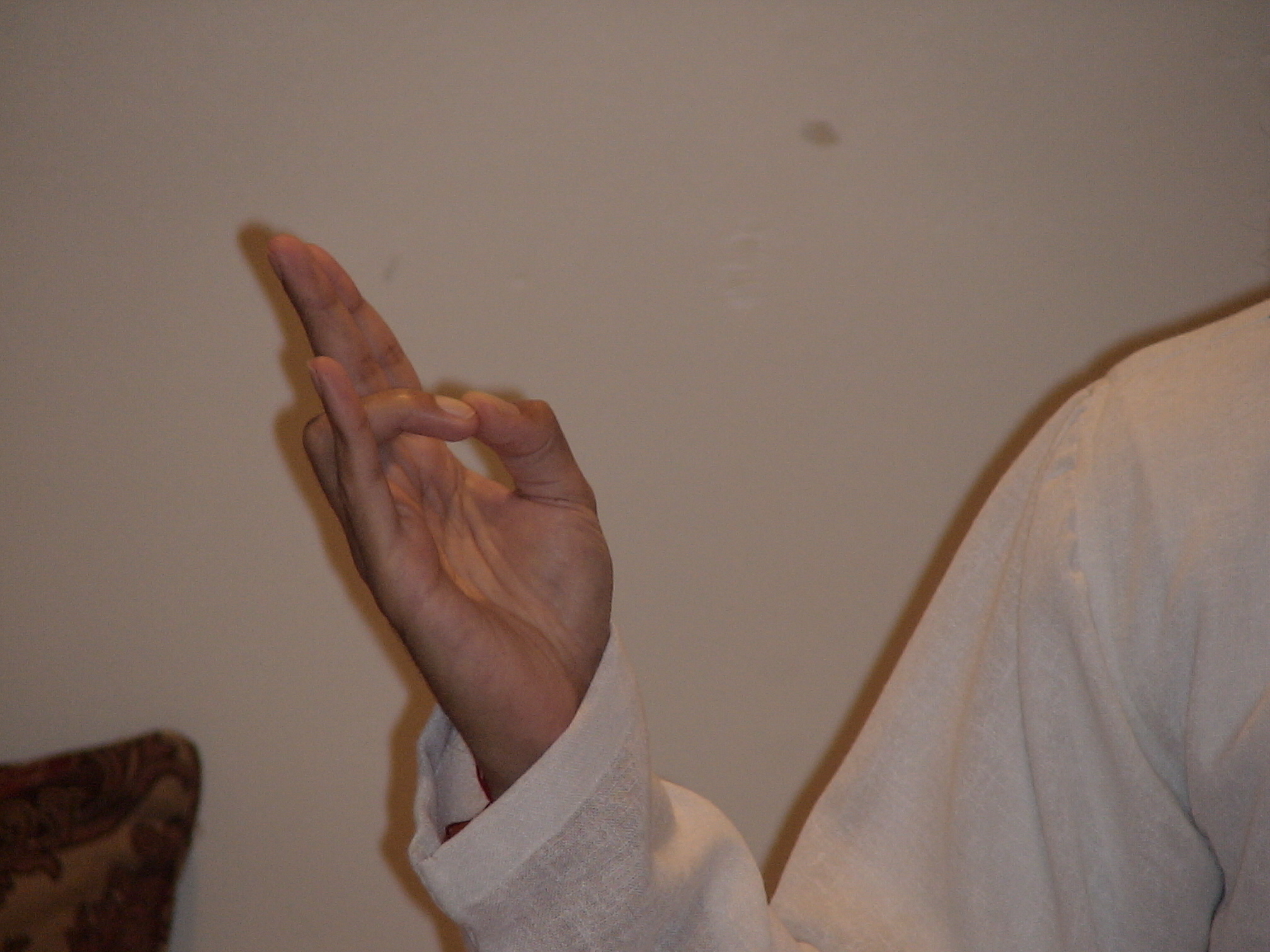
Right Hand Position (Surya Mudra)

Left Hand Position (Gyan Mudra)
____________________________________________________________________________________-
Symptoms of Kundalini Awakening
Real Life Experiences & Descriptions of
Kundalini Rising
Are you going through a kundalini awakening episode
or experience? Let’s find out…
Kundalini awakening symptoms are truly a very
intriguing subject. Really there is no correct answer to the question,
"What are the symptoms of Kundalini Rising?", as thankfully, each
of us is absolutely unique and thus, on a unique trajectory on the path to
Kundalini Awakening. That said, there are some common kundalini
experiences that are often reported, which I would like to share with you in
this article.
Although we can draw up endless lists of symptoms
from third party accounts, I would like to instead make this series about
kundalini symptoms that you or I have actually experienced. In this
article, I will give a recent account from one of my students about what she
experienced shortly after class, and then I will add my own kundalini
experiences and observations as well.
In the comments section, I encourage you to add any
kundalini awakening experiences or symptoms you have felt, so others can
better understand what they might be going through. Here is the recent
email I received from my student, Aida:
Aida’s Experience of Kundalini Awakening:
I am a student of the "Gentle Kundalini
Class". I just finished taking a series of exercise specifically
for the spine.
As I left the class I felt energized as I usually
feel after each class, but this time it was a little different, I was
feeling extra aware of my surrounding. Like a light turned on. My back
was so straight. It lasted all day.
If I could go to class every morning I would go. It
makes my day start right in every way. And there are times when I am not
feeling like going to class and I push myself to go and do not regret
it.
Thank you for being my teacher.
Aida D.
For those interested, here is a link to the Spinal
Warmup Kundalini Yoga Kriya we did in class that day. Thank you
Aida, for sharing your personal experiences with us.
This particular experience of kundalini is very
interesting and significant. This is because it is the common
experience of advanced meditation and of kundalini yoga. In the
article, Powerful
Kundalini Yoga Battles Profound Zen Meditation, I described my own such
experience with kundalini awakening, but not from doing kundalini yoga, but
instead from doing Silent
Mind Meditation!
Aida’s experience points at the two things that
all yoga and meditation boils down to. Energy and Awareness.
My favorite description of Kundalini Yoga is,
"The Yoga of Awareness," and as you see from her account, she felt
more aware, as the energy of kundalini had risen up her spine. In
meditation, it is the same. The demand for intense awareness,
in order to comprehend the thought process via direct perception, leads to
energy (kundalini) rising up and elongating the spine. Awareness then
follows.
Jiddu
Krishnamurti describes this experience of kundlaini energy flowing up
the spine as "The rush of water filling up and thus causing a pipe to
stand erect."
When we insist that the spine be straight during
meditation, it is simply to facilitate this awakening and thus, to assist in
being more aware. I have experienced kundalini rising and puling up
with such force, during meditation, that it sometimes make me feel as if I
am going to be launched right off the ground or as if it’s going to pull
my head off and up into the sky.
Symptoms of Kundalini Awakening:
I am going to describe some of the physical symptoms
my students or I have felt due to kundalini awakening. I know there
are many emotional and mental symptoms as well, and you are welcome to share
those with us in the comments section below. I am grouping the
experiences into 3 categories, common, uncommon and rare, according to what
I have observed.
Common Kundalini Awakening Symptoms:
- Tingling in the body and brain region. Also
sometimes described as ants walking, tickling energy or flushes of
energy. The brain being flushed with energy is quite pleasant :-).
- Heat or cold in the system, or running along
various channels and chakra centers.
- Fluttering or twitching of muscles.
- Pinching or burning in various regions of the
body or brain.
Uncommon Kundalini Awakening Symptoms:
- Pressure in the Third Eye Region (Ajna Chakra).
This is pressure, tingling or other sensation in the center of the
forehead. Can go on for years (14 years and counting so far for
me). Caution: If the pressure, due to certain
practices, intensifies to uncomfortable levels you feel are
"immense", you should cease that practice and consult a
competent kundalini yoga teacher.
- Sudden bursts of energy anywhere in the body.
These are almost always short lived, from a few seconds to a few
minutes.
- Spontaneous yoga asans or kundalini yoga
movements. They may come on spontaneously, or they may take over,
as if on auto-pilot when one is practicing Kundalini
Yoga Kriyas or Exercises (For an example see article: Explosive
Kundalini Rising in Class Today).
- Kundalini Shakti rising up and elongating the
spine.
- Incredible feeling of love and desire for your
partner (not ordinary lust, alcohol induced or otherwise :-).
Usually comes upon you spontaneously, deep in the night. Sex feels
like it’s the first such experience and the intense feelings of
attraction emanate from somewhere beyond yourself.
- Unfortunately, pain in the lower back, back of
the neck and headaches.
Rare Kundalini Awakening Symptoms:
- Experience of divine light within. Very
intense light, usually pure white and incredibly beautiful. I call
it the Radiation of the Lord.
- Tremendous vibratory energy (sometimes feels like
it’s coming from the inner ears). Very blissful, but can
intensify to the point where it would completely overwhelm your
consciousness if you let it.
- Spontaneous bliss, intensely pleasurable.
- This one is a bit scary. Complete paralysis
of the body. Complete immobility and rigidity takes place.
As with the all consuming vibratory energy, it requires some courage to
allow.
- This one is exceedingly rare. I have
experienced it only once in my life, and have only ever read about it
being experienced by one other - the master of awareness, G.
I. Gurdjieff. The arms and legs churn like that of a baby.
It happens naturally and cannot be simulated. It is also intensely
pleasurable and quite a remarkable experience.
There are of course a wide range of transcendental
experiences, some of which you will find described in the category Spiritual
Enlightenment Experiences. Above, I have provide those that are
more commonly associated with kundalini awakening, although many would
argue, including Swami
Vivekananda, that all enlightenment experiences have to do with
kundalini entering the brain region in some capacity.
So if you have experienced some kundalini symptoms
as well, please do share them with us below. I think it will benefit
others identify if what they are going through is actually symptoms of the
ever mysterious kundalini awakening.
____________________________________________________________________________________
__________________________________________________________________________________________________-
Reference Sires:-
meditation,
free
online meditation program, meditation
for enlightenment, how
to meditate, awaken
the senses, meditation
for refining senses, meditation
for vision, meditation
on sound, meditation
for hearing, zen
meditation, flow
of attention, flow
of kundalini, dangers
of meditation, trataka,
candle
flame gazing, concentration
meditation, dhyana,
ajna
charka, kshetram,
pituitary
gland, meditation
for brain development
meditation,
guided
meditation, meditation
technique, free
online meditation book, daily
meditation, meditation
and relaxation, sound
awareness meditation, choiceless
awareness, tat
vam asi, observer
is the observed
____________________________________________________________________________________________________________

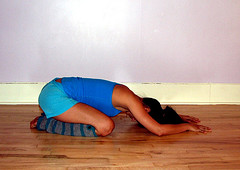
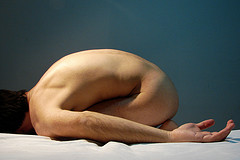

 Makar means crocodile and hence this yoga asana is also know as the crocodile
pose. This is one of the best yoga poses for stress.
Makar means crocodile and hence this yoga asana is also know as the crocodile
pose. This is one of the best yoga poses for stress.






















